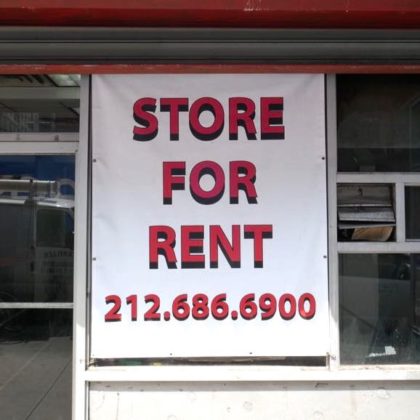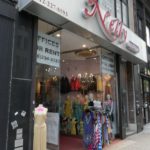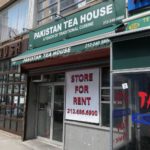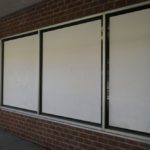The Desertification of Street-Level Tribeca
 For the third year in a row, I walked every block in Tribeca, counting storefronts that appeared to be available. In 2015, there were 100; in 2016, there were 127. This year, I found 134*—not as bad as I feared, but not exactly a turning of the tide.
For the third year in a row, I walked every block in Tribeca, counting storefronts that appeared to be available. In 2015, there were 100; in 2016, there were 127. This year, I found 134*—not as bad as I feared, but not exactly a turning of the tide.
The knee-jerk reaction is to blame landlords for expecting more than the market can bear, and there are certainly many examples of businesses that would’ve liked to stay in the neighborhood, but they couldn’t find affordable space. The bigger issue, however, is that people just don’t shop the way they used to. We can beg each other to patronize local shops instead of buying everything online, but no one ever got rich expecting people to do the right thing for someone else.
As developer Billy Macklowe said in April, “I think retail is fucked, plain and simple.”
What will become of street-level Tribeca? We have a glut of vacant street-level real estate that has been valued based on outdated norms, and I can’t see a future where it’s worth what it once was. Even if a serious contraction were to dramatically lower rent, are there enough businesses that could thrive here? I wouldn’t bet on it. The low density that makes living here so lovely is brutal for businesses.
We’ll always need some retail businesses, of course: The self-care industries—fitness, skincare, cosmetics, etc.—continue to invest in the neighborhood; preschools and other services aimed at young children appear to be doing well; restaurants should be able to survive, if the city and state don’t regulate them to death. And industries currently being squeezed out—such as parking—might find a way back in. Some storefronts could be converted to residential, although at a substantial financial loss. In general, however, I honestly don’t know what can be done with so much unnecessary commercial real estate.
···················
*Methodology is the same as in previous years. The area surveyed is bounded by Canal, Broadway, Murray, and West. I did not include the following: spaces where we know something is coming; not-yet-built buildings where the amount of retail is unknown; pop-ups and other temporary retail (such as condo sales offices); or anything on Canal, because that’s an entirely different ecosystem from the rest of Tribeca—although it too is decimated, especially the north side. And the year-over-year numbers aren’t perfect, because I’m not rigorous about making sure that I counted a vague space—such as the southwest corner of Broadway and Reade—the way I did before. I’ve organized the photos below into quadrants, mostly for my own convenience, so please don’t get hung up on whether you think an area is appropriately defined.
Northeast Tribeca
Southeast Tribeca
Southwest Tribeca
Northwest Tribeca

























































































































































Of course not so long ago, there were few if any retail stores on the the side streets. When the ‘pioneers’ arrived most ground level, if not whole buildings were offices/warehouses. Trucks delivered goods to specialty distributors, often clustered near their ‘competitors’ on the same block – electrical parts, paper, rubber products, wheels, spices, etc. Even a few dairy product distributors, the remainder of Wash. Market.
I continue to see food and gyms looking for retail space, but more and more stores are being taken by non-traditional retailers. Offices, event spaces, and flea markets come to mind. I find it interesting the number of flea markets that have taken prime space in Soho in the past year or so.
I believe ground floor space still has value in NYC. Tourists and locals do want experiences and have money to spend. I think the goal is to make the space a positive unique experience for the consumer. I think the new Soho Nike Store putting in a basketball court and treadmills to test products, interactive flea markets where you meet the artist/owner, food halls, and the iPic theater are the type of thing we will see more of.
From NYT “In a Thriving City, SoHo’s Soaring Rents Keep Storefronts Empty” 8/23/17:
Some landlords have started finding ways to generate income. Pop-up stores — which take over a space temporarily, with a predetermined end date — offer landlords what Beth Rosen, a retail broker at RKF, a national firm, calls a “kind of a band-aid for the space,” bringing in revenue but not foreclosing the possibility of a permanent rental paying the higher asking rate. Ms. Rosen said that SoHo landlords are more willing than ever to permit the short-term stores, “if they can’t get the rents they want, and it’s a way for the tenant to get comfortable.”
After a successful run as a pop-up store on Spring Street, Aerie, a lingerie and clothing chain developed by American Eagle, is looking for a more permanent spot in SoHo. Untuckit, a store featuring high-end shirts designed to be worn loose, also wants a long-term lease after testing the market on Prince Street.
Some landlords are offering short term leases while they hunt for higher-paying long-term tenants, giving store owners months free for a limited period, or offering money or a discount on the rent to be used toward building a store.
From NYT “Pop Up Goes the Retail Scene as Store Vacancies Rise” 5/30/17:
In SoHo, where pop-ups are especially popular, the range in rents can be significant. Long-term tenants have been paying in some cases up to $150,000 a month, brokers and tenants say. But pop-ups can get deals for $25,000 a month. They generally pay all their rent upfront and agree to leave with a few days’ notice if a longer-term tenant is signed.
While some buildings may be hard to get into, others seem more inviting, like 543 Broadway. That is where Vintage Twin — which is owned by Ms. Elias and her twin sister, Morgan — has been set up since April, and which bustled with shoppers on a recent weekday afternoon. A tie-dyed Grateful Dead concert T-shirt from the 1990s was $244.
Several pop-ups have set up camp at the address, a Beaux-Arts edifice, since Carlo Pazolini, a shoes and accessories store, closed in 2015 after a four-year stay.
“To keep the neighborhood alive and vibrant, you need to have retailers occupying space, especially in today’s day and age,” said Jared Epstein, a principal of Aurora Capital Associates, the building’s landlord.
Similarly, last year, Aurora installed the Broadway Market Company, a pop-up with various vendors who sell handbags, jewelry and stationery, in a vacant building it owns nearby. Its lease is expected to run about 18 months.
Likewise, an Aurora-owned building in SoHo in May welcomed Artists and Fleas, another market with tables and racks from different vendors, which replaced a 10,000-square-foot Armani Exchange store that closed in March. Artists and Fleas has committed to a one-year lease, Mr. Epstein said.
Many of the retail spaces in Tribeca have a narrow street presence and deep stores (25 foot wide building where the retail frontage is shared with the residential entrance), not conducive to retail (they generally want the opposite – wide frontage and not too deep.) So that structural issue coupled with low foot traffic does not help our retail neighbors.
I’m in the camp of putting this issue squarely on the shoulders of greedy landlords. The bubble has burst for them and the sooner they recognize and address the issue, the better for all of us.
We can’t hope and pray that consumers will suddenly start spending again, but landlords can wise up and get a grip on what the current market realities are and renegotiate more reasonable lease terms with existing tenants.
Secondly, city agencies, as you rightly cite are bone crushing to small business owners…from FDNY to DOB to tax authorities to Health Dept and on and on and they are relentless and fines are out of control. Small business owners can make a career out of ensuring compliance with all the various agencies and getting fined and going to court for the multitude of citations that may come your way even when you run a completely legitimate business. No wonder people are shutting their doors and sadly walking away from Tribeca.
Sidebar: When you say “restaurants should be able to survive”, I would strongly disagree based on the number of recent closures in our neighborhood and the NUMBER ONE reason given is high rents. How many bowls of pasta or salads does one have to sell to offset a rent of say $20-30K??!!
Delivery and/or liquor need to be a big part of any restaurant’s business around here, to cover the rent and other fixed expenses.
I agree with you Bob, the greed of landlords is crushing the economics of street level stores.
I think Tribeca needs an economic developer to speak with these landlords and understand why they are leaving stores empty and what could be done to get retail in these open spaces.
Obviously, the landlord has a right to leave it empty indefinitely, but that’s not good for the community.
Don’t forget the DSNY who write tickets for just about anything in Tribeca and leave Chinatown alone.
The commercial real estate market – rental real estate hasn’t even begun to find a clearing level. While the issues w/ city regulations mentioned above are spot on, there are many other neighborhoods that are currently much more conducive to small businesses in terms of pricing & population density – see Brooklyn (for now).
All the vacant stores in IPN wanted to stay. Imagine asking the pizza place that was here over 20 years for $50,000 a month in rent? That’s a hell of a lot slices they’d have to sell. And what’s happened with Gee Whiz also at $50,000 and a third of its original size with less business bc it had to raises prices way up? The IPN deli and Socrates are still missed. All bc of inordinate rent increases when the leases expire. So it is basically the landlord getting too hungry. I feel the government has to be helping them in some way with the empty stores. If they were fined for it, you’d see how fast they’d be filled. Horrible disgusting situation that
has to be remedied.
Independence Plaza wants to do a significant buildout of their stores and wanted the plaza empty to do this work. It wasn’t about rent.
I find it interesting that many people think they have a right too tell a landlord what s/he should rent their private property for. If they want to leave it vacant while holding out for a higher price, THAT’S THEIR RIGHT! Have you all gotten so “progressive” that the meaning of “private property” is lost on you?
Private property is still regulated by laws, including rent-control and rent-stabilization laws in some cases. There could be rent control laws on commercial space as well.
I wonder: How are other cities (including those in other countries) dealing with this? Are there laws controlling levels of commercial rents? Laws governing how and how long properties can be left vacant?
One problem with CRC is the potential for more vacancies. Landlords may be even more wary of renting for long terms, not just for locking in low rents now (as they seem to be) and end up being even more risk-averse and less likely to give a marginal store tenant a chance–or mom-and-pops vs corporates. (It’s not unlike labor markets, where unemployment rates are generally higher internationally where it is harder to fire or lay off employees.)
CRC may end up discouraging new business if it ends up being like residential rent control–good for old, long term tenants in their apartments protected by government regulation and bureaucracy but bad for newcomers who struggle to find an affordable apartment on the free market.
Some U.S. areas including NYC had commercial rent control, but most if not all jurisdictions got rid of them.
One example overseas is the United Kingdom:
“While legislation akin to SBJSA may not exist in any other part of the United States, something quite similar exists in the United Kingdom. The Landlord and Tenant Act of 1954 established the right of tenants to renew their leases—what the English call ‘security of tenure’—with landlords able to regain their property in certain circumstances. As in SBJSA, a landlord and tenant can agree on the rent in their new lease or turn to an arbitrator or court to set a new rent.
“There are three differences between the UK’s policy and SBJSA, and the first two might make the UK’s policy more flexible for landlords.
“First, the British law allows landlords and tenants to agree on a contract in which the tenant signs away their right to lease renewal. For instance, property owners of highly desired spaces in popular shopping centers might only take on tenants who agree to give away their right to lease renewal. Second, there is no required length of the lease. Third, when the court decides on a new rent, it looks only at one factor, not a dozen: the comparable market rents in the surrounding area. This could be a disadvantage to the landlord, whose operating costs and mortgage costs would not be taken into account.”
https://citylimits.org/2016/06/13/trepidation-around-proposal-for-regulating-store-rents-in-nyc/#britain
March 2015: “Why Barcelona Is Giving Special Preservation Status to 228 Historic Stores”
“When the plan is voted through after this year’s election (and it’s all but certain that it will be), these businesses will have extra planning restrictions placed on them that will make it effectively impossible to significantly alter their décor, and difficult to change their use.”
https://www.citylab.com/amp/article/388261/
(6 months earlier, in “Historic Loss May Follow Rise of Rents in Barcelona,” the NYT reported, “Barcelona has set up a commission that is reviewing 380 store buildings to decide whether they should be granted special protection.”)
One interesting report from 2016:
“This report outlines a range of ideas that elected officials, business owners, and community leaders have come up with for keeping space affordable and ensuring that entrepreneurs continue to thrive:
1. Broaden Ownership [retail condominiums …]
2. Reduce the Power Imbalance in Landlord-Tenant Negotiations
Another set of policy ideas would give small businesses certain rights when it comes time to renew their leases. […]
3. Zone for a Local Business Environment
Zoning can be a powerful tool for creating a built environment that provides plenty of opportunity for local entrepreneurs. Key strategies include protecting the varied fabric of established commercial districts, ensuring an ample supply of small spaces, and adopting business diversity ordinances that encourage a mix of different types of businesses.
4. Set Aside Space for Local Businesses in New Development […]
5. Create a Preference for Local Businesses in Publicly Owned Buildings […]
6. Recognize Businesses as Cultural Landmarks”
https://ilsr.org/affordable-space/
The rents are too high, of course, but landlords may not be able to afford to lower them if their expenses on the building (mortgage etc) are also extremely high.
This is the conundrum of the speculative NYC real estate market.
I don’t think anyone here it “telling” landlords what to do, but rather suggesting that they may be in a much better place financially if they renegotiated their existing leases with tenants to prevent vacancies which in the long run will be much more cost prohibitive for them.
Not even the big money center banks ala Chase or Citi or nail salons want to dole out $50K-75K/month for a space they can easily rent out for half that price in many other locations in NYC.
Let’s see if anyone buys “the storefronts at 345 Greenwich—currently home to VCafé and Giorgia” anywhere near their asking prices of “$6.5 million and $5.5 million, respectively” per https://tribecacitizen.wpengine.com/2017/08/17/in-the-news-elderly-woman-hit-by-truck/
The Amazon + Whole Foods deal is also a sleeping giant:
* Starting this week, Whole Foods is dropping prices as part of the Amazon deal.
* WF is going to start putting Amazon Lockers in it’s locations, which means that they become distribution centers for pretty much anything you can buy. If the Tribeca location gets lockers, curious how this plays out with Target.
* Amazon is also doubling down on multiple retail segments (see the Nike deal) so further down the road it becomes a threat to a number of categories.
So funny. You know that when every blog starts talking about the death of retail, go the other way.
Landlords should look at the long term health of the community and street they own by supporting retail business with reasonable rents. Fair market value is a relative term.
Also, the city should support retail instead of punishing business. Mayor de Blasio fines retail that pays more than $250,000 in rent.
I do not know what “landlords should” do, but maybe people who know what landlords should do, should try net leasing the empty storefronts themselves from landlords, paying them the monthly rent, and then subleasing said storefronts.
Simple economics. a business can only afford a certain portion
of its income for rent expense.
I don’t see the vacant store front on the corner of Reade St and Greenwich (former NYSC space)…It appears that they have been doing some work in that space recently. Does anyone know what is going there?
An early education center called KinderCare: https://tribecacitizen.wpengine.com/2017/03/24/seen-heard-another-casualty-at-brookfield-place/
To not think most landlords squeeze as much as they
can out of their tenants is just plain silly. The old
timers were different-or a lot of them were. You
can walk around TriBeCa and see who the
“old” landlords are. It is obvious. In the 80’s
Soho, West Village and the East Village had such
vibrant shopping scenes and the landlords
survived. The spaces were filled with small
businesses. I don’t shop online and know I
am living in the dark ages but I love sticking it
to the man in my own little way.
Walk where you live people. Oh and check out
UWS and UES for some old time shoppping too. Somehow those landlords are surviving.
“You can walk around TriBeCa and see who the ‘old’ landlords are. It is obvious.”
Serious questions: I may be dense, but who are the “old” landlords in Tribeca to whom you refer? Who were the “old-timers [who] were different”? Please fill us in. It is not obvious to me. Thank you in advance.
I think the “old timers” are some of the buildings that became co-ops in the late ’70’s and early 80’s and kept their retail spaces rather than selling them off. I live in such a building. We have only had two tenants since I moved into the building in 1990. We have an excellent tenant and we charge a fair rent so he can remain.
On another note, James, maybe you can clarify this. I have heard that a landlord gets a tax benefit for a vacancy at a level of their “claimed” rent which may be well above the rent paid by their prior tenant.
Also there is proposed legislation before the City Council that provides for the right for arbitration of rent level and terms on a lease renewal. No idea what chance this has of passing. Some of the candidates for City Council from District 1 support this.
No one is keeping a space empty by advertising an inflated rent because of the alleged “tax credit” to be had from unrealized rents. This is a myth.
While losses generally shield profits in any business, there is no special, disproportionate income tax or property tax benefit for a (long-run) vacancy or for having an inflated “advertised” rent and keeping a space vacant. One pays income tax on one’s actual income, not on hypothetical losses, just like in every other industry. You would still make more money renting the space than not, all other things being equal and considerations of a landlord’s mortgage terms and obligations aside.
With respect to property taxes, they are figured as a statutorily-set percentage rate by property type multiplied by the City’s estimate of building value (assessment) which is itself derived from a formula combining comparable asset values and actual income and expenses reported annually to NYC Finance. While less actual income may lead to a successful appeal to lower the property tax, it is because one has collected less actual income due to a vacancy or unusually large but legitimate repair expense, etc.
There is no disproportionate property tax credit calculated based on an “asking rent” for a vacant space, inflated or otherwise.
One reason some co-ops charge below market rents is because they MAY still be bound by the 80-20 rule that permits them to pass tax deductions on to shareholders.
Those rules were relaxed in late 2007. The last of the 10-year leases affected (with deflated rents)
should be expiring shortly.
80-20 is STILL one of three possible tests that a co-op must pass to pass-through tax deductions. Depending on the co-op, if they can’t pass one of the other two, they may be forced to comply with 80-20.
The other two rules are far easier to comply with:
* 80 percent of the total square footage of the co-op building must be used or be available for use by (residential) tenant-shareholders; or,
* 90 percent of the expenses of the corporation must be spent for the benefit of shareholders.
If one’s co-op has not figured out in 10 years (!) how to comply with either of these rules, it may be time for one to select a new board president or managing agent.
There are many factors contributing to the large numbers of retail vacancies in the city.
I think people need to consider that there simply is a lot more retail space than their used to be. Buildings used to have a couple of stores and the rest of the ground level presence was occupied by either industrial or residential or other building use, but it was not storefronts. In the last 20-30 years much of this space was converted to retail, which was then filled by national retailers (many of whom were banks and pharmacies and other larger-type operators). Many of the smaller amenity operators (shoe shines, laundrys, bodegas, underwear shops, diners, etc.) have been displaced, as landlords sought to combine their smaller spaces to make them attractive to the larger national retailers who would pay higher rents and commit to longer term leases.
Society’s shopping habits have shifted to more online purchasing in the last 5-10 years and many of the larger retailers have reduced their bricks-and-mortar presence, leaving a lot of retail available.
Yes, there are many “greedy” landlords who have jacked up rents, making them prohibitively expensive, for restaurants, as well as amenity-type retailers. But another thing to consider is that many individuals have purchased buildings in the last few years with huge tax burdens and at inflated purchase prices which basically make it impossible for them to lease their spaces at lower rents. That’s not to excuse them for making incorrect assumptions about supportable rents in the area, but they have gotten themselves into a pickle on this front.
So…it’s a complicated problem.
And one which cannot be placed solely at the feet of landlords. The City’s regulations and taxation rules need to be amended to address these issues going forward.
But as long as there are real estate speculators in NYC who are willing to purchase buildings with the hope of generating more income than the last guy, these issues will remain…
I would be very interested in leasing in Tribeca for my business but the rents are just WAY TOO high to make it realistic.
Ultimately, rents will need to come down but it seems like it will take a while given how slow the movement is. But with more space coming on-line from new developments and the already high supply, a tipping point may be near.
Tribeca has become as bleak as it was after 9/11. Long term LOCAL businesses gone. Area now populated by transient tenants with a dorm mentality who live on delivery and really do not care. IPN has been one of the biggest offenders for catering to this, even though they’ve had to drop residential fair market rents. They overuse apartments with people who st home, get delivery and beer and do not go out.
Places come and go, I have never seen so many women’s lingerie shops appear and disappear.
It was a pioneers stronghold, gone are the galleries or anything artistic. Most people who have lived here any length of time try to shop local. Big chains like Subway, Banks and NYSC can’t sustain the rents. I was told recently that at ‘Duane Reade by Walgreens’ certain items are priced by zip code. Because I compared the $1 increase from the store on broadway.
Lower Manhattan population is too low and has little foot traffic
( like soho) for stores to even cover the rents. As some one mentioned, you are not going to sell 50,000 slices of Pizza. 10k is a bargain for commercial space. Some Condo owned retail space the rent is kept within reason as they’d rather have it occupied. There is n’t even a regular Chinese restaurant around here.